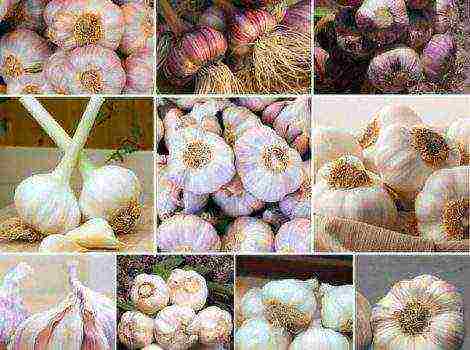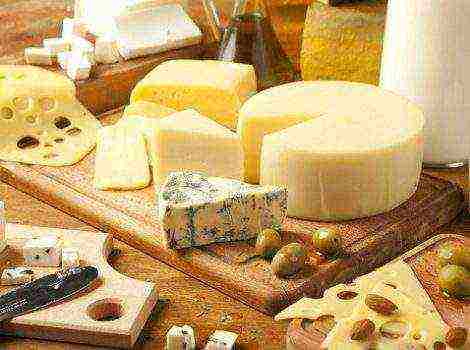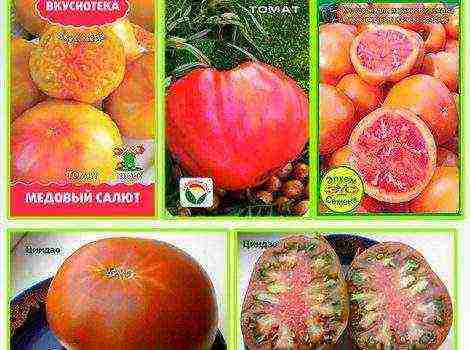Content
- 1 The very best early grape varieties
- 2 The best varieties of early grapes with a description and characteristics
- 3 Early grape varieties for regions with description and characteristics
- 4 Gardeners reviews
The climatic features of the middle lane make it possible to grow heat-loving crops, in particular grapes, practically throughout Russia. Given the likelihood of early frosts, many gardeners, when choosing varieties, prefer plants with an early or super-early ripening period. So the chances of getting a harvest are significantly increased. And the susceptibility to fungal infections in early-maturing grapes is lower.
The very best early grape varieties
The assortment of varieties with an early ripening period is quite large, which complicates the choice for inexperienced winegrowers. You can trust in this difficult matter rating indicators, which distinguish the best representatives of the culture by several factors at once: yield, resistance to diseases, the onset of the fruiting phase after planting seedlings.
The following grape varieties are considered popular among farmers and private traders.
Libya
Libya grapes combine great taste, resistance to diseases and climatic conditions... Recommended for growing in Krasnodar, Primorsky, Stavropol Territories, the Volga Region and the North Caucasus.
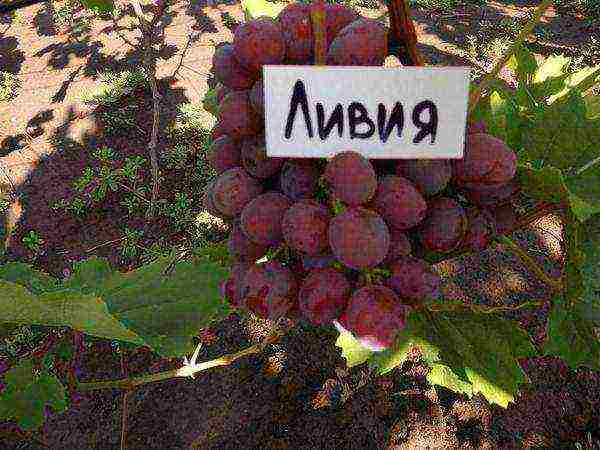 Libya
Libya
A brief description of:
- vegetation - 105 days;
- vigorous bush with powerful roots, the vine develops very intensively;
- fruits have a persistent nutmeg aroma, which lasts for several months after harvest;
- berries are round, slightly elongated, pink color, weight 10-12 gr .;
- the pulp is of medium density, the skin is barely felt;
- sugar content - 20% with an acidity of 6-7 g / l;
- frost resistance - to minus 21 degrees;
- agricultural technology is simple, even a beginner can handle;
- the use of berries is universal.
The variety was obtained by an amateur breeder V.V. Zagorulko. The plant features large dense brushes about 25 cm long and very early ripening period.
Adler
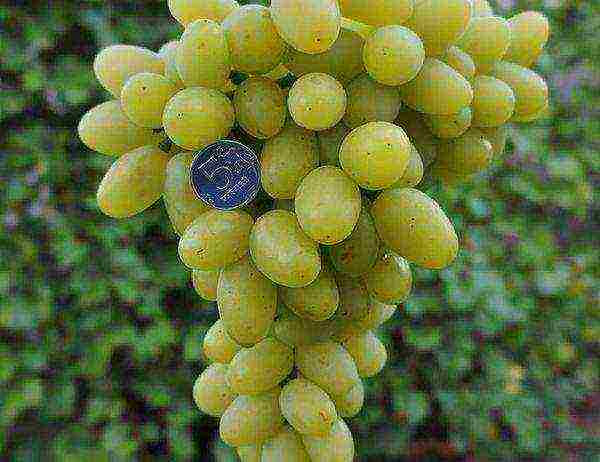 Adler
Adler
The grapes were bred by breeders from promising varieties: Talisman and Augustine. Bisexual flowers provide good pollination, in particular a stable harvest. The hybrid took exclusively advantageous qualities from the parents, which was highly appreciated by the growers of central Russia.
A feature of Adler is considered safety of presentation berries on the bush throughout the month after ripening.
A brief description of:
- vegetation - 115-120 days;
- vigorous bush with rapidly growing vines;
- berries are large, rounded, slightly elongated, amber-yellow in color, weight 10-11 grams;
- the mass of the bunch reaches 500 grams;
- sugar content - 18-22% with acidity 3.4-3.7 g / l;
- frost resistance - to minus 24 degrees;
- the plant is tolerant to powdery mildew and mildew, there is a high resistance to gray rot;
- dense skin ensures long-term preservation of the crop and good transportability.
Veles
A hybrid bred by an amateur breeder V.V. Zagorulko, who crossed Rusbol and Sofia. Seedless grapes have bisexual flowers, but additional pollination is recommended to increase yields (by almost 20%).
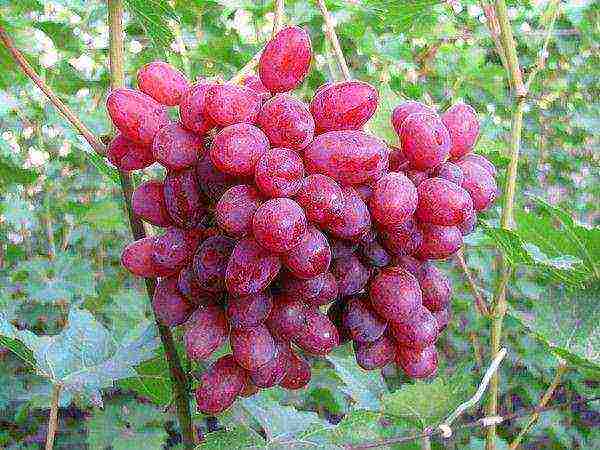 Veles
Veles
The plant develops intensively, forming a branched bush with abundant ovaries (more than 35 eyes). The Veles variety is recommended for cultivation in the temperate climate of Belarus, Russia and Ukraine.
A brief description of:
- vegetation - 100 days;
- a bunch of cylindrical shape reaches 1.8-2 kg;
- berries of medium size (5-6 gr.) oval, pink color;
- sugar content - 17-22% with an acidity of 5-7 g / l;
- pulp of medium density, has a pronounced nutmeg taste and aroma;
- tall bushes with powerful roots;
- frost resistance - to minus 21 degrees;
- the plant has a strong immunity, shows high resistance to mildew, tolerant to gray rot;
- yield 10-15 kg per bush.
Veles grapes are classified as raisins.
Julian
The Julian variety was bred after crossing Rizamata and Kesha, inherited the best qualities from the parents. Among the advantages: high yield, disease resistance, unpretentiousness to weather conditions.
 Julian
Julian
The author of the work is an amateur breeder. In a short period of time, the berry has become incredibly popular thanks to interesting taste and valuable commercial qualities.
A brief description of:
- vegetation - 95-105 days;
- bunches of conical shape or shapeless hang 700-1000 gr.;
- berry (14-17 gr.) has a dense pinkish skin, but when eaten, it is practically not felt;
- the plant tolerates winter frosts to minus 23-25 degrees;
- fruits are not prone to cracking;
- high sugar content (18-19%) does not attract bees;
- there is a long storage period and good transportability.
Delight
Very juicy and sweet berries of Delight, yellowish with a white waxy hue, do not leave indifferent those who have tasted them at least once.
 Delight
Delight
A brief description of:
- vegetation - 110-120 days;
- tall bush;
- the bunch has a conical shape, weighs an average of 1.4-1.9 kg;
- oval berry with a moderately dense skin, weight 10-12 grams;
- sugar content - 19-26%, acidity - 5-9 g / l;
- frost resistance - to minus 25 degrees;
- high rates of taste and marketability, good transportability;
- yield per bush - 6-8 kg.
The Vostorg variety was bred by domestic breeders, who first crossed the Zarya Severa and Dolores, and then the resulting hybrid was diluted with the Russian early.
In almost all indicators, the result of the work of scientific workers has high marks, which is reflected in the title.
Anniversary
The parents of the Jubilee variety were Taifi steady and Delight red. First-class grapes take a worthy place in the ranking of winegrowers.
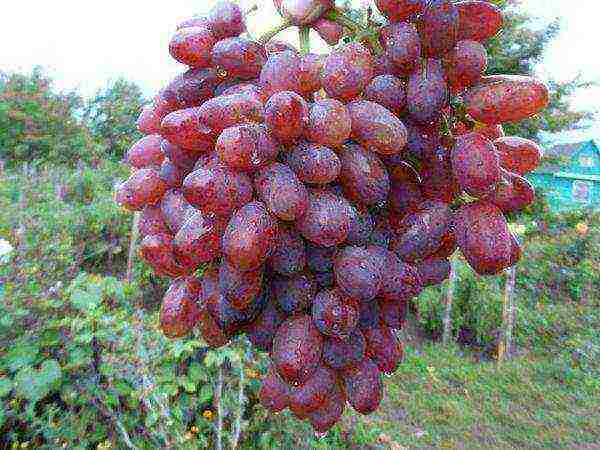 Anniversary
Anniversary
Its main advantages: early ripening, interesting honey taste, high resistance to various fungal infections. Despite the ability to accumulate sweetness well, no damage by bees or wasps is observed.
A brief description of:
- vegetation - 115 days;
- vigorous bushes with intensively developing vines;
- the bunches are cylindrical, medium density, hung at 400-500 grams;
- oval berries of a dark pink color weigh an average of 6-7 grams;
- sugar content index 18-20% with acidity 6-7 g / l;
- frost resistance - to minus 24 degrees;
- there is a high resistance to mildew, tolerance to powdery mildew;
- load on the bush - 35-40 eyes;
- yield - 9-12 kg per bush;
- fruits are well preserved, do not lose their presentation during transportation.
Monarch
Variety
Monarch
was bred by the famous breeder E.G. Pavlovsky, who crossed the Talisman and the Cardinal.
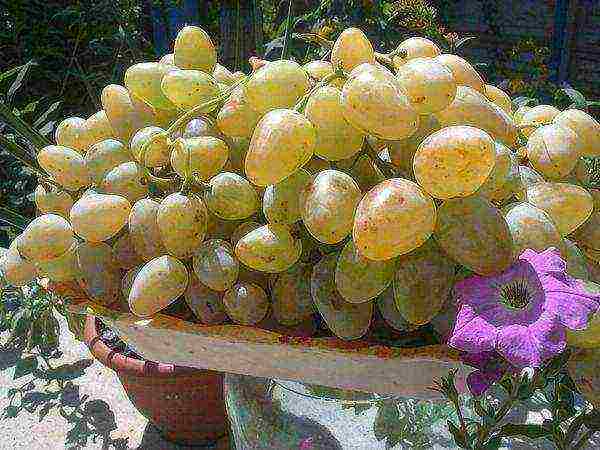 Monarch
Monarch
A brief description of:
- vegetation - 120-125 days;
- vigorous bushes with rapidly developing shoots;
- bisexual flowers, which ensures good pollination;
- the ripening period falls in the third decade of August;
- cylindrical bunches hang 600-800 gr .;
- oval berries weighing 20-23 grams. have a yellow color;
- taste and commercial characteristics are excellent, there is a nutmeg note;
- stable yield - at least 7 kg per bush;
- frost resistance - to minus 23 degrees;
- the plant is practically not affected by fungal infections, but weakly resists mildew;
- for a long time, the fruits retain their presentation after ripening, remaining on the bush.
Jupiter
The culture is one of five seedless table grapes that has wild plant roots... This fact, scientists explain extraordinary resistance to frost and weather disasters.
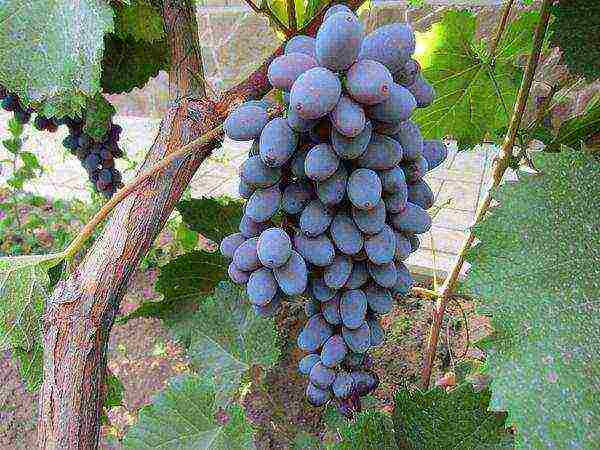 Jupiter
Jupiter
No less unique is the taste of Jupiter's berry, which has fruity notes, nutmeg and even citrus. Americans refer to the fruit as a cocktail of flavors.
A brief description of:
- vegetation - 110-115 days;
- flowers are pollinated on their own, do not require additional measures;
- bunches are conical in shape, average looseness and density;
- oval berries weighing 4-6 grams. painted in red or dark purple;
- the weight of a ripe brush is 300-500 grams;
- sugar content - 21% with an acidity of 5-6 g / l;
- frost resistance - to minus 27 degrees;
- disease resistance at the level of the best varieties;
- the use of the crop is universal.
Violet
The grapes were bred by Russian breeders who used Northern and Hamburg Muscat for crossing. The hybrid is resistant to frost and climatic conditions. Bisexual flowers provide good pollination, which is the basis for stable yields.
 Violet
Violet
The main places of cultivation: Kherson, Odessa regions., Republic of Dagestan, Krasnodar Territory.
A brief description of:
- vegetation - 120-130 days;
- tall bush with intensively developing shoots;
- small clusters of regular conical shape, weight 150-180 gr .;
- berries of a dark purple color with a waxy coating, weight 1.5-2 grams;
- the skin is firm, but very sweet, edible
- sugar content - 21-22% with an acidity of 4.5 g / l;
- the plant can withstand frost to minus 27 degrees;
- the use of the crop is universal;
- the culture grows well on plains and in mountainous areas;
- the taste is characterized by a range of shades, the aroma contains nutmeg and rose;
- resistance to fungal diseases is noted.
Anniversary of Novocherkassk
The honey taste of berries and aesthetic enjoyment of the beauty of a poured bunch from the first time wins the recognition of the Novocherkassk Jubilee variety, which inherited the best qualities from eminent parents (Talisman and Kishmish Radiant).
 Anniversary of Novocherkassk
Anniversary of Novocherkassk
A brief description of:
- vegetation - 115-120 days;
- the bushes are tall, the vine is rapidly gaining strength;
- harvesting is planned for mid-August;
- the berry is large, round-elongated, weight 8-12 g, yellow-pink color;
- a bunch of medium looseness gains a mass of 0.8-1.5 kg;
- the plant tolerates frost to minus 23 degrees;
- there is a high resistance to fungal infections, as well as mildew.
Any of the listed early varieties of grapes will be a good acquisition, will favorably emphasize the landscape of the personal plot with beautiful massive bunches.
.
The cultivation of grapes was carried out even before our era. It is not known thoroughly who first realized the qualities of grapes and discovered it as a food product. But it cannot be denied that the history of grape growing begins from time immemorial.
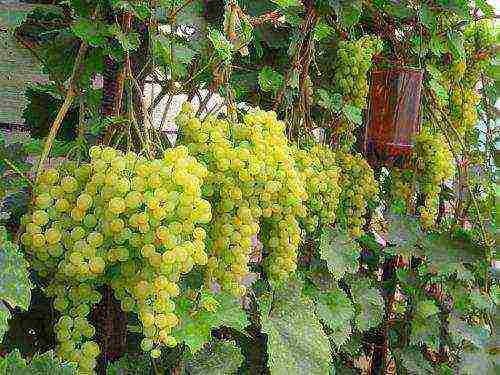
Aleshenkin grapes - a classic representative of early varieties
Early grape varieties
Grapes come in early, mid, late and super early ripening periods. Early varieties and super early varieties are the most popular, as it takes four months or less to fill the berries and acquire a sweet taste. This is the most optimal and profitable way of planting and growing crops.
Planting material care consists of pruning, watering, fertilizing, and proper planting. An early harvest can be obtained by choosing the right seedling variety and taking proper care of the grapes.
To determine which grape variety is best to plant for an early harvest, you need to choose it from the following list:
- Kishmish, Kodryanka and Sofia.
- Laura, Transfiguration and Arcadia.
- Delight, Aleshenkin and Jubilee.
- Libya, Augustine and Victor.
- Timur, Veles, Victoria and Monarch.
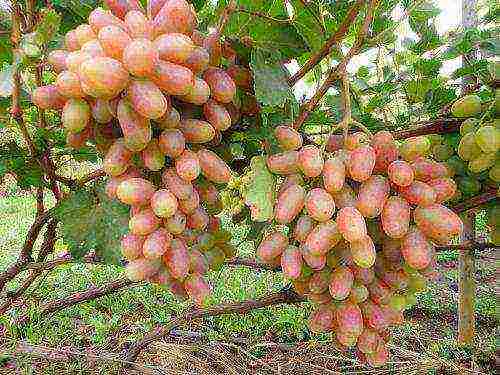
Grape Transfiguration gives the most beautiful berries and large clusters
The raisin grape variety belongs to the early varieties and yields a harvest one hundred and ten days after planting. The harvest is round and light-colored, each weighing four grams, is seedless and sweet-tasting. The variety is disease-resistant and cold-resistant.
The ripening period of Sofia is one hundred and fifteen days from the moment of vegetation. The berries become large and weigh an average of five grams each, the color of the crop is light with a characteristic nutmeg flavor and aroma. The variety is resistant to cold weather and disease.
Codryanka can be classified as very early, since it gives a crop already in the third month. The codryanka bush grows strongly and produces dark berries. The taste of the variety is pleasant and does not have specific notes. This variety will fight back fungal disease and will endure cold weather.
An early look of Laura gives light berries weighing nine grams with a pleasant taste. The berries contain large seeds. Growing the species is convenient because it is easy to transport and store. The variety tolerates cold and disease resistant, the variety is grown as a covering type. At the exit, berries weighing about nine grams are obtained.
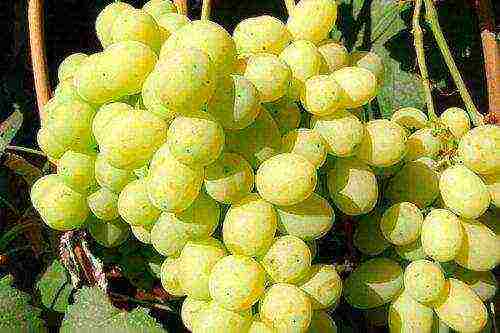
Laura grapes keep well during transport
The cultivation of Arcadia is carried out within one hundred and twenty-five days. The harvest is large and the weight characteristics of the variety reach two kilograms. The taste is simple. what attracts consumers in this variety. Each light-colored berry reaches a weight of about fifteen grams. The variety tolerates transportation and long-term storage.
At the beginning of summer, the transformation ripens, a large bush of grapes with bright reddish berries. The taste of the variety is excellent, and the harvest ripens steadily. It also fights disease and pests.
Another stable variety of delight gives a harvest on the 120th day and has an average growth rate, the berries are light and sweet.
The Aleshenka variety gives a crop for one hundred and twentieth days from the moment of vegetation. The color of berries, five kilograms of weight, acquire a light shade, the species is resistant to disease and cold
Jubilee grapes yield early harvest, the weight of each bunch of harvest reaches one and a half grams, with red and large berries. A variety of grapes with a pleasant taste also calmly resists diseases and tolerates frost.
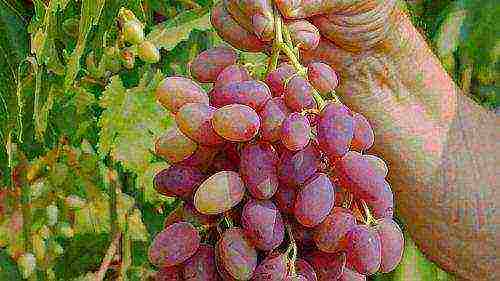
Bunches of Jubilee grapes can weigh up to 1.5 kg
Libya grapes yield a harvest in one hundred and tenth days from the moment of vegetation. The harvest has a nutmeg flavor and a sweet taste. It is susceptible to fungal diseases, but is hardy to cold.
The Augustine variety is very resistant to disease and cold. The harvest is ready by mid-August, the color of the berries is light, the taste is sweet. The variety is not demanding in care. The weight of each bunch reaches five hundred grams.
Variety victor is light berries of an early ripening period, which are demanding in the care provided. It is resistant to frost and disease. the harvest ripens by the second half of September.
The Timur variety gives a crop on one hundred and sixteenth days from the moment of planting and does not grow much, each bunch weighs about six hundred grams. The color of the berries is light. the taste is sweet. The planting material resists fungal diseases and is able to grow in northern latitudes.
Velez, Victoria and Monarch are dark early grape varieties that are cold-resistant and give a consistently high yield.

Veles grapes - decoration of any site
Super early grape varieties
Among the grape varieties, there are also varieties that require a minimum maturation of the vine. A crystal with a high yield of the species belongs to the super early ripening period. The ripening rate is one hundred and fifteen days. The bush grows to a medium size. Each bunch weighs about two hundred grams. The berries are light and sweet, each with two grams. The species is capable of repelling diseases and grows under severe frost conditions. The crystal is used for winemaking.
The super early look of Julian is ready on the hundredth day since the growing season. The crop is large and bright reddish. This species is also capable of surviving cold weather and species diseases.
The rate of ripening of the extra harvest is equal to one hundred and twenty days, the bushes grow strongly, each bunch reaches a weight of half a kilogram. The grapes are large, light in color.
On the one hundred and twentieth day from the moment of the growing season, the harvest of the maharach ripens. This variety does not tolerate subzero temperatures and certain diseases become fatal for the species. Dark grapes with few seeds have a pleasant taste.
Variety Cardinal of dark harvest color, gives berries with a juicy sweet taste and pleasant aroma with nutmeg notes. The harvest is ready on the one hundred and twentieth day, the amount of the harvest is large, but it is not able to resist pests and frosts.
The super early beauty grapes yield large dark berries that are frost-resistant and have a sweet taste.
Another type of plant sensation also ripens in the early stages with large dark-colored grapes, it calmly refers to the cold.
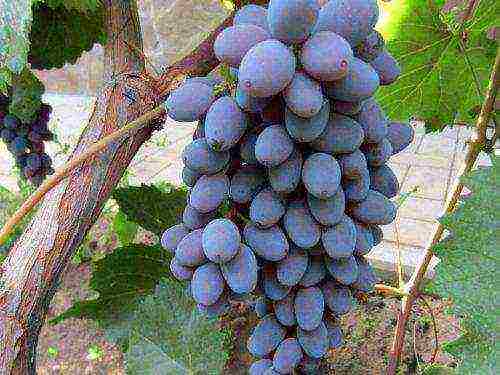
Jupiter is an early black grape
The Jupiter variety is similar in characteristics to raisins and has nutmeg notes in taste, calmly tolerates frost and pests.
The early Pleven variety belongs to the table species with light sweet berries that need shelter for the winter and careful care, because they are affected by pests and fungal diseases.
The buffet grape ripens by the end of August and produces large clusters with dark berries. The variety is resistant to disease and cold.
The lily of the valley grape variety yields in early August. On the one hundred and twenty-fifth day, a harvest of sweet berries is formed, which are resistant to frost and fungus.
The grape varieties are varied and among them you can easily choose the most suitable type for a given region.
Subscribe Be aware of new products on our site
Since ancient times, the vine has been considered a symbol of fertility and wealth. Dark grape varieties are grown to make wines and cognacs, white-fruited grape varieties are an amazing dessert, without which no feast is complete. But the main achievement of grape selection is rightfully considered the appearance of early and ultra-early varieties, they are grown in the south and in central Russia, in the Urals and in Transbaikalia. If you get acquainted with the agrotechnics of a thermophilic culture and choose a variety suitable for the climate of the region, then at the height of summer you can get a decent harvest.
The best varieties of early grapes with a description and characteristics
There are several hundred varieties of dessert grapes with a ripening period of 100-110 days, among them there are ultra-early varieties, the fruits of which are ready for consumption within 3 months from the moment the first buds bloom. From the experience of modern winegrowers, it can be judged that such forms of grapevine ripen not only in the southern, but also in the northern latitudes of our country.An important point is the choice of planting material, taking into account the main characteristics of the culture, climate and soil.
Early table grape varieties
Grape forms, which ripen before anyone else, are valued by gardeners for their early maturity and increased immunity to many fungal diseases that develop during temperature extremes. In most cases, the earliest birds in the vineyard are domestic and overseas hybrids produced in recent decades.
Early ripe grape varieties are grown in the southern regions and in the northern regions because they have time to ripen and collect enough sugars in 3–3.5 months from the moment the foliage blooms until the fruit is fully ripe. In such a short period of time, you can get not only a plentiful, but also a tasty, sweet grape harvest only when the shape of the grapes is selected according to the ripening time and taking into account the weather conditions in the region. Viticulture has become widespread in the Far East and Siberia thanks to ultra-early table grape varieties.
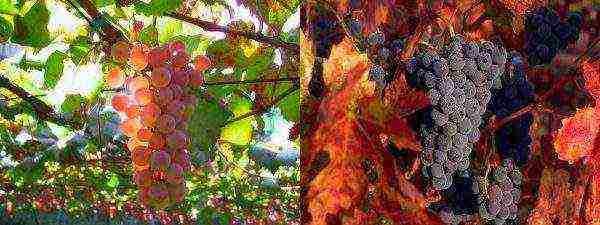
Early maturing grape varieties are found in every garden today.
Ultra early table grape varieties
One of the most famous grape varieties - Codreanka or Black magic - is a hybrid, the result of crossing two parental varieties: Marshal and Moldova. Ripens in 105-115 days. During this period, the vine manages to fully mature, and the bunches gain weight and sweetness. A vigorous Codryanka bush is loaded on 18–20 shoots. The plant needs a short cut. The ultra-early hybrid is distinguished by its high survival rate, resistance to spring frosts and summer drought. The first harvest is obtained in the 2-3rd year after planting: the bunches weigh from 600 g to 1000 g, the berries are elongated, dark purple, juicy, crunchy, contain 2-4 seeds. Sugar accumulation up to 19%, with an acidity of 6–7 g / l. Resistance to fungal diseases and weak insect infestation makes winegrowers opt for a hybrid.
Depending on weather conditions, the variety is prone to peas. The plant is undemanding to watering and feeding, but does not hibernate without shelter (especially in the northern regions of the country).

Ultra-early grape variety Codrianka
The Harold table grape was obtained by Russian scientists from Novocherkassk by crossing the grape varieties Muscat Leto and Arcadia, the code name is 1–12. The frost-resistant hybrid has an early ripening period of 90–105 days. A tall bush requires normalization and regular pruning so as not to overload the bush. The bisexual flowers of the hybrid are used as a pollinator.
Harold has dense conical clusters weighing from 500 to 800 g each. The berries are small, elongated, light green with an amber tinge at maturity (weigh 5–7 g), there are 1–3 seeds. Sugar accumulation level 20%, acidity 5 g / l. Harold's berries make an amazing nutmeg wine, and fresh fruits are suitable for desserts and compotes. This grape variety tolerates transportation well, does not peas or crack.
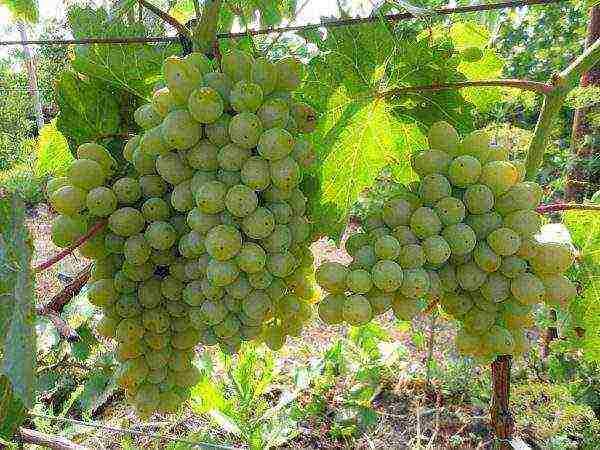
One of the earliest varieties is the Harold grape
Russian early table grapes were obtained by crossing the varieties Shasla rosy, Severny and Michurinets... The hybrid is quite tall, has a thick stem and forms on a trellis. Ripens amicably and early, withstands frosts down to -23 ° С. Ripening period - 105-115 days. Bunches are small, medium density, elongated, weighing 300–500 g. The berries are round, dark pink with sweet, crispy pulp (8–10 g). The sugar content of the fruit is 21%, the acidity is 6–7 g / l.
The harvest is plentiful, appears in 3-4 years. But an adult plant gives a stable harvest for many years. The grapes are unpretentious and endure sudden changes in negative temperatures. Differs in high resistance to rot and fungal diseases, with insufficient watering, the berries crack and are damaged by wasps and ants.
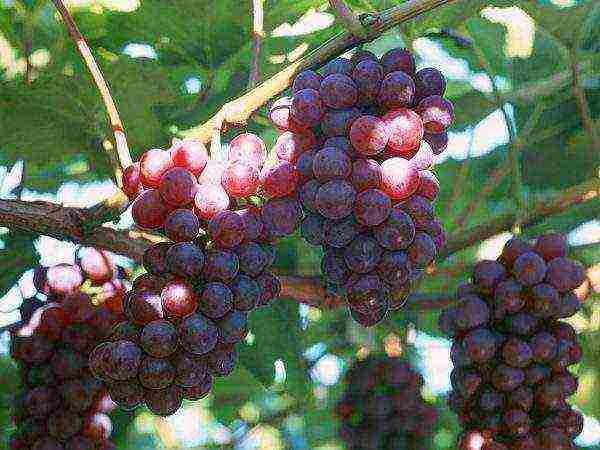
Ultra-early grape variety Russian early
The variety has been bearing fruit for more than one year without forming, processing and sheltering for the winter in the Central Black Earth Region in an arbor form.The grapes are distinguished by a decent harvest - up to 25 kg per bush, its only drawback is that it can hardly withstand the attack of wasps and ants. For wine, you should choose the most ripe and whole (undamaged) fruits, otherwise the drink will spoil and sour.
Another form of the vine appeared relatively recently, but it is becoming more and more popular every day - the Gourmet variety. The hybrid was bred by the breeder Viktor Nikolaevich Krainov about 10 years ago by crossing the Kishmish and Talisman varieties. Flowers on a female type plant. The early gourmet produces pale pink, oval berries weighing 8-10 grams with a firm skin. This grape is loved by many modern gardeners for its subtle Muscat notes and floral nuances. Fruits contain 16% sugars and 5 g / l acids. Bunches of cylindrical shape gain weight up to 1300 g, from a bush get up to 8-10 kg. The harvest from medium-sized table grapes Gourmet is harvested at the end of July, the fruit ripening period is from 105 to 115 days. Bunches of this variety are stored in cool rooms at temperatures up to +10 ° С for more than 6 months. The hybrid needs regular preventive treatments against powdery mildew and gray rot, periodic feeding with organic matter and minerals.
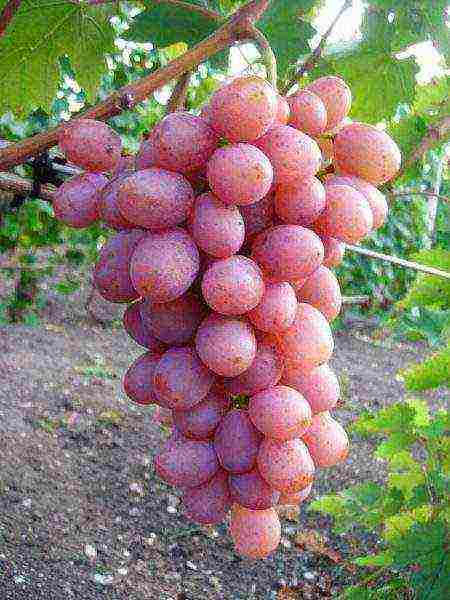
Early ripening table grape variety Gourmet
Table: ultra-early grape varieties with description and characteristics
Photo gallery: ultra early grape varieties
Super early table dark grape varieties with description and characteristics
The grape vine with dark fruits has always been valued for its delicate aroma, excellent taste and decorative qualities. The red and blue berries of early maturing grapes are ideal for wines, compotes and jams. Among the many early varieties, unpretentious and frost-resistant forms are especially popular.
Early pink grape varieties are distinguished by bright pink (in full ripeness - raspberry-red) berries with an unobtrusive fruity taste. Several subspecies of superearly table grape varieties with red and dark red fruits have been bred. These forms include the Transfiguration variety, it has excellent characteristics and is used as a graft. Ripens 110-115 days after bud break. It quickly takes root on rootstocks, is resistant to low temperatures and unpretentious to the soil. The berries are pink with a red tint, juicy, fragrant, the bunches are dense, elongated, gaining 1.5 kg each. The transformation is grown in many regions of our country and the variety is loved for its disease resistance and consistently high yield.
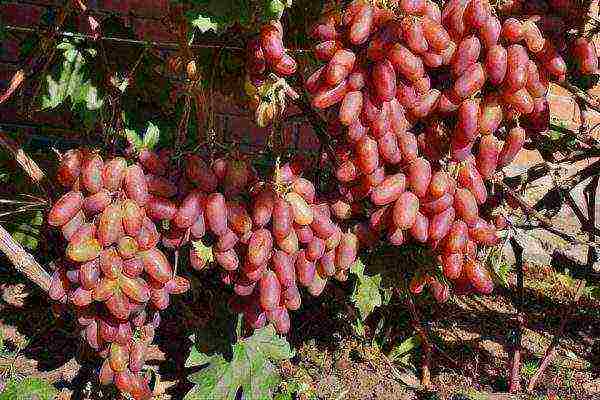
Early ripe grape variety Transformation with pink-red fruits
An early ripe hybrid Black Cherry, developed by Ukrainian breeders, ripens in mid-July. The berries are dark purple, large, with a pointed tip, the flesh is juicy, pink-red with the aroma of overripe cherries. The weight of the bunches is from 700 g to 1500 g, the flowers are bisexual. The plant is powerful, branched, requiring pinching and regular pruning. A relatively new hybrid has gained fame over the past decade, is distinguished by the ability to produce crops on stepchildren. Berries with a dense skin tolerate transportation well and are stored for a long time.
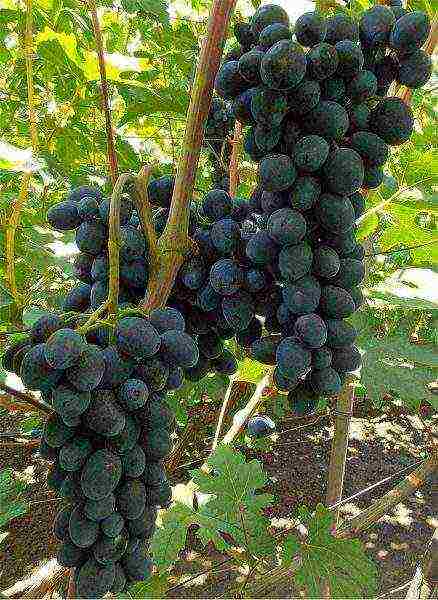
An early ripening grape hybrid Black cherry has rich, dark purple berries
Baikonur grapes ripen in 105–110 days, endure the overload without loss and give a bountiful harvest. Berries are dark purple with a red tint, pointed at the end, fragrant, with juicy pulp. Contains 2-3 seeds. The bunches are dense, weighing 400-700 g. The berries are not prone to cracking, periodically damaged by wasps. Bushes are tall, vine pruning is medium (for 6 buds). Berries are valued for their taste and color, suitable for liqueurs and wines.
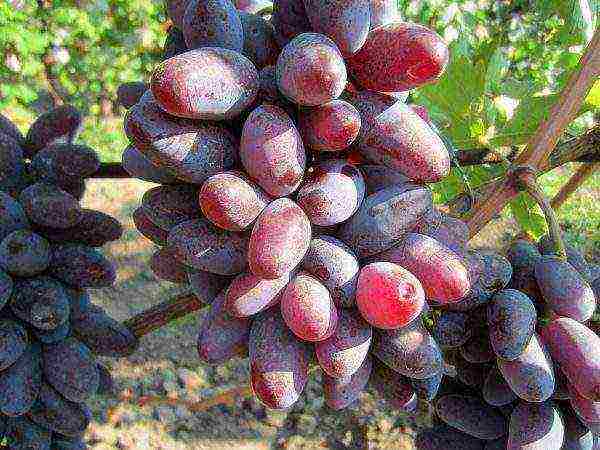
Early grapes Baikonur
- The early ripe grape Aivaz, obtained in Ukraine (Moldova + Cardinal), ripens in 115 days. The berries are dark blue, large, oval, sweet; the taste is ordinary, with sourness. Bunches in the form of a cone, weighing 400-600 g. The bushes are powerful, ripen by 70%.The average yield is up to 6–8 kg during the growing season.
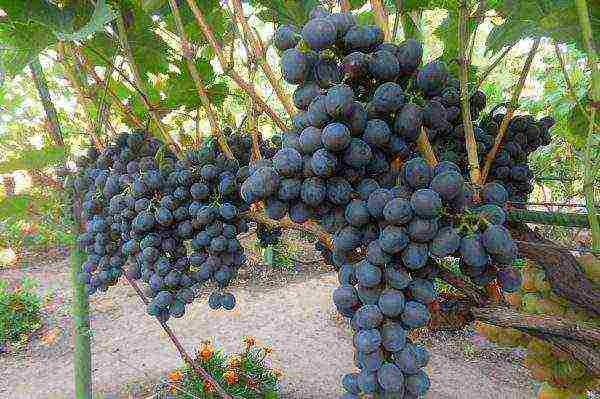
Early ripe grade Aivaz
- Beauty Seedles (USA), has medium-sized dark blue berries with a delicate skin, characterized by sweetness and harmonious taste with fruity notes. Crossing of 2 varieties - Queen of Vineyards and Black Kishmish. The fruits are seedless. Bunches - up to 800 g. Tall bush with dark green leaves.
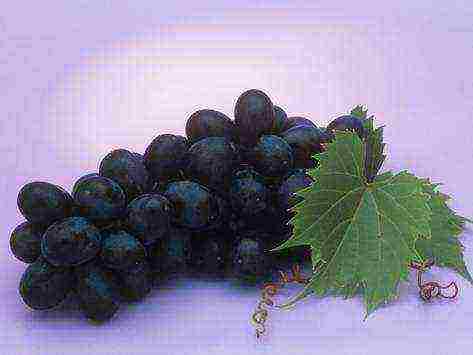
An early ripening variety of American selection Beauty Seedlis
- Zabava is an early table variety of Ukrainian selection (Kodryanka + Lora). The berries are large, elongated, blue-violet, juicy with nutmeg notes. Flowers are bisexual. The weight of bunches of medium density is 700–1000 g. Sufficient sweetness is gained after 100 days. The bushes are vigorous, the shoots ripen by 90%.
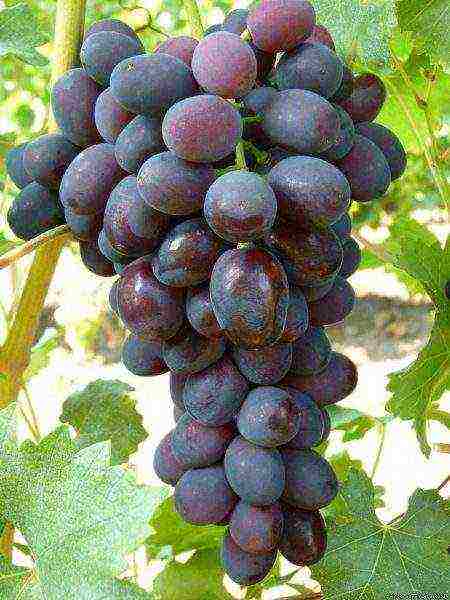
Early ripe grapes Zabava, bred in Ukraine
- Favorite - early ripe dark grapes from Bulgaria. On a loose, conical bunch, medium-sized blue berries ripen, sweet and sour with a nutmeg aroma. The weight of the bunches is up to 600 g. The seeds are 3-4 pieces. Ripens in the 10th of August.
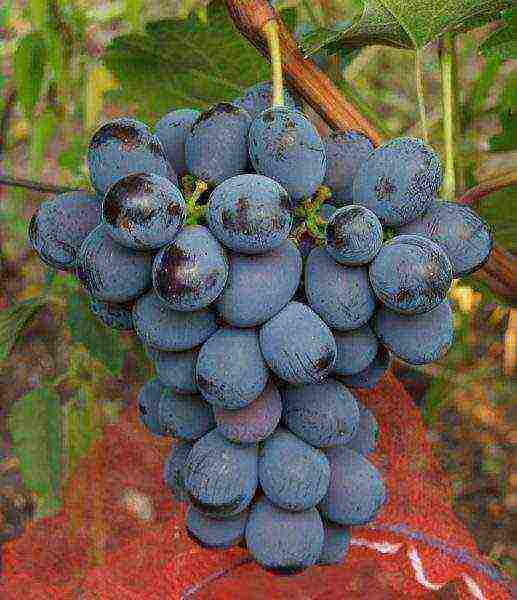
Early ripening variety from Bulgaria - Lyubimets
- The famous Russian variety Taman is the result of crossing two species - Criulyansky and Cardinal. Productivity of table grapes up to 10 kg per bush. The berries are dark blue, fleshy, juicy, with a fruity-nutmeg aftertaste. The hybrid is vigorous. The plant is resistant to powdery mildew.
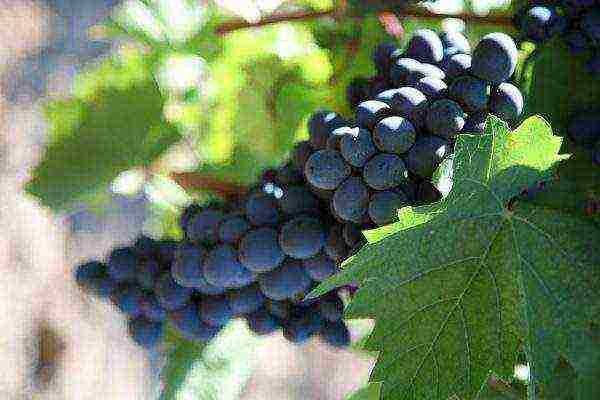
Hybrid Taman with early ripening
Super early table light grape varieties with description and characteristics
Plants with light green and yellow fruits are prized for their delicate taste and soft skin. The variety is not often used for the preparation of wines and tinctures. Berries that do not have a dark pigment are well tolerated by allergy sufferers and are ideal for baby food.
The early ripening variety Arcadia (first name - Nastya) ripens at 115–120 days. The grape form was obtained in Odessa by crossing two varieties - Cardinal and Moldova. Arcadia has yellow-green, large, elongated berries, moderately sweet with a nutmeg aroma and juicy pulp. Flowers are bisexual. An early ripening and vigorous hybrid requires pruning for 8–10 buds, tolerates an increased harvest load (3–5 bunches) without loss. The grape form does not tolerate waterlogging, preventive treatments for powdery mildew are required.
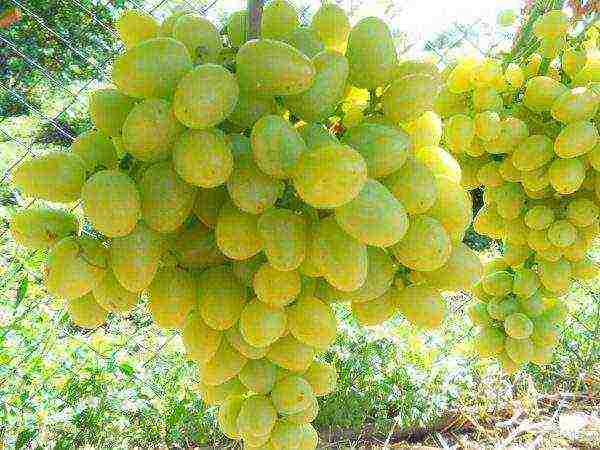
An early ripe hybrid of light varieties of Arcadia has a bountiful harvest
Bazhena grapes were brought to Zaporozhye more than ten years ago. Varietal berries of an egg-shaped, yellow-green color are distinguished by a nutmeg aroma and a sweet cherry flavor. The bunches are large, loose, weight - 700-1100 g. Flowers are bisexual. The bushes are lush, but vigorous. Ripening period - 105-110 days. Vine pruning is done short to medium. The plant is treated with mildew and oidium 2 times a year, and the vine is covered for the winter.
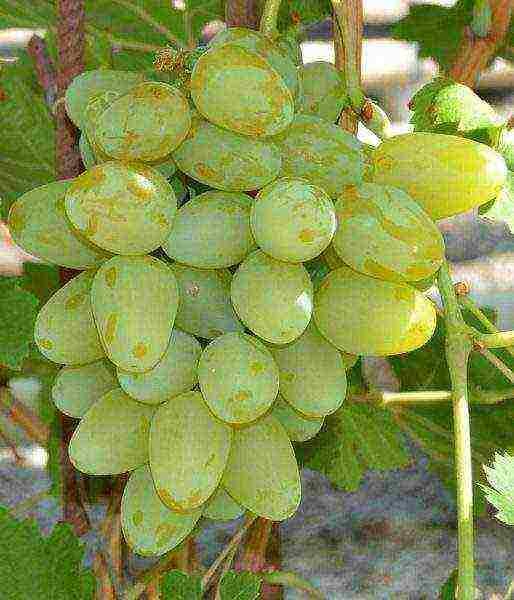
Early ripe grape variety Bazhena
Hercules grapes, resistant to recurrent frosts, ripen on 95-105 days from the beginning of the growing season... The dining form combines the parental qualities of two varieties: Elegant and Arched. The berries of the hybrid have a shade from yellow to pale pink, fleshy, juicy, aromatic, with a waxy coating. Bunch weight - up to 800 g. Cut the plant into 6-8 eyes. The grapes are not peas but are susceptible to powdery mildew.
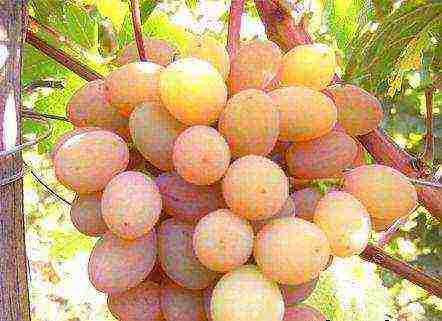
Ultra-early grape variety Hercules with light pink fruits
- The early ripening variety Vega of Ukrainian selection combined the quality features of Demeter and Arcadia. Grape-shaped berries are oval-cylindrical, light yellow, with a delicate nutmeg-fruity aroma. Vega's bunches are large, conical up to 1.5 kg, ripen at the end of July. Vigorous grapes have bisexual flowers and require medium pruning.
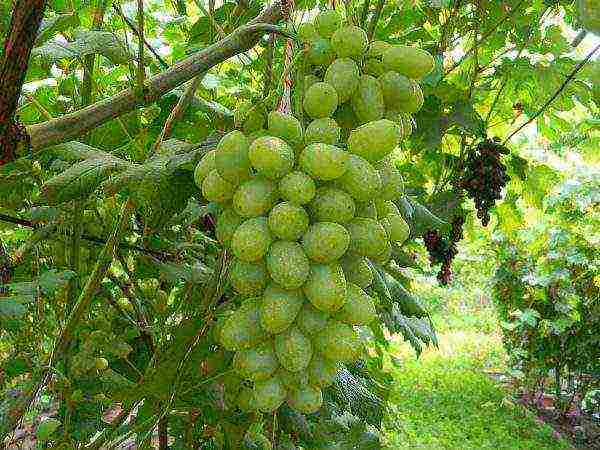
Early ripe variety Vega with light green fruits
- The amber-yellow berries of the early Galahad grape variety are prized for their amazing taste and high yield. The weight of the bunches is 600–1100 g; ripen 95-105 days after bud break. The flowers are bisexual, the shoots ripen by 85%.

Galahad, ripening at the end of July, takes on a characteristic brownish tint in the sun
- Grape variety Raspberry super, originally from Ukraine, is distinguished by white, round fruits, moderately sweet (sugar 19%) and aromatic; there are no more than two seeds. The weight of the bunches is 500–700 g. The first harvest is due in 105–115 days. The grapes are cut into 8-10 buds, the shoots ripen by 75-85%.
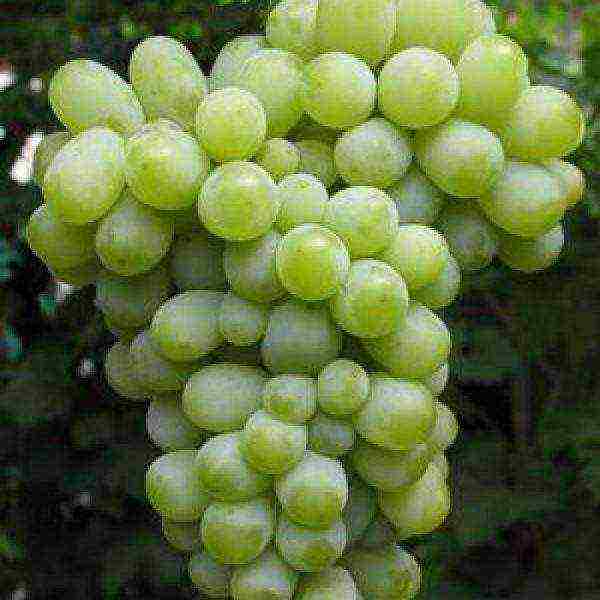
Ukrainian variety Raspberry with round milky-green fruits ripens in early August
- The seedless variety Rusbol of domestic selection ripens on the 95–105 day. Berries are oval, white with a "tan", loved for their fruity notes and moderate sweetness, are valued among gardeners. Harvest up to 10-15 kg per bush, the average bunch weighs 800 g. Shoots ripen completely.
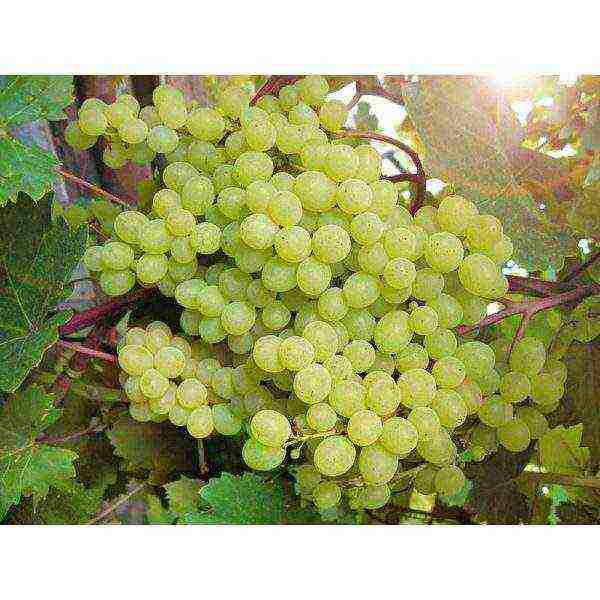
Rusbol ripens in the last decade of July
- A new Russian Hip-Hop variety with abundant fruiting, light yellow round berries, sweet with sourness and a moderate nutmeg aroma. The mass of the bunches is 500-700 g. The ripening period is 100-110 days. The flowers of the plant are bisexual.

Small clusters of early maturing Hip-hop grapes, moderately loose
The most productive early varieties of table grapes with a brief description
Of the dark-fruited varieties, Julian is especially prominent, with clusters of up to 1.5 kg and his "relative" - Jubilee Novocherkassky (0.6-1.2 kg). One plant is capable of producing up to 20-25 kg of selected berries. Often, an enviable harvest is obtained from the Yubiley variety - up to 15-18 kg, with an average weight of bunches of no more than 800 g. The amazing Velika grape hybrid with dark purple berries, bred in Bulgaria, is famous for clusters of up to 1 kg and gives up to 12-15 kg of berries for the season. The fruits ripen in 115–120 days and are remembered with subtle nutmeg and berry notes.
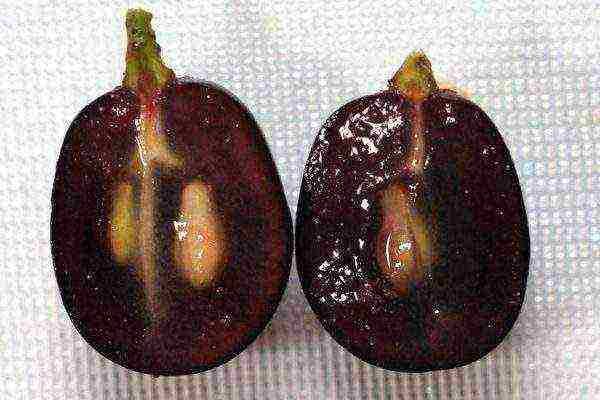
Velika table grapes from Bulgaria
Veles with pink fruits is characterized as a productive variety, with an average mass of clusters of about 1.8 kg. In favorable summer months, the variety bears more than 18–20 kg of fruit per plant.
Among the first most productive varieties, practicing gardeners note:
- Arcadia - 25-30 kg;
- Laura - 25-28 kg;
- Early Russian - 20-24 kg;
- Codryanka - 20-22 kg;
- Gala - up to 23 kg.
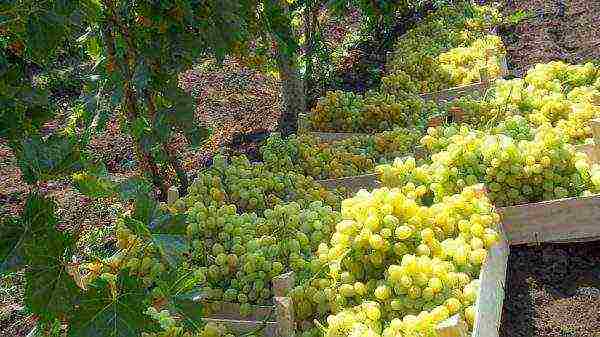
Early ripe grape harvest Arcadia
Abundant fruiting - up to 15–20 kg - in the varieties Preobrazhenie, Bazhena, Gurman, Rusbol, Libya, Timur.
The average weight of Russian early bunches does not exceed 700 g, and Codryanka - 900 g, but with proper care, the harvest ripens on the bushes from late July to early September.
A high yield is obtained from grape forms, which are capable of giving repeated ovaries in axillary buds. Often, early varieties form 3-4 inflorescences on fruiting shoots. Despite the average weight of fruit clusters of 400-700 g, more than 20 kg of berries ripen as a result. The yield depends on how often the vine is watered and fertilized. Pruning also plays an important role in fruit production.
The sweetest varieties of early table grapes
Bunches of grapes, the fruits of which gain a sugar content of more than 20% and the acidity remains in the range of 5-7 g / l, will be the sweetest and tastiest. The leaders in the vineyard in terms of the sweetness of berries are raisins. An early ripe hybrid Kishmish 342, ripening on 115–120 days, ranks first among the “sweet” varieties. The maximum amount of sugars by the time of ripening is gaining Super Extra - up to 26%, Libya - 24%; Julian - 22-24%.
Table: Indicators of sugar accumulation for some grape varieties of early ripening
Tason, Bazhena, Harold (22-24%) are some of the sweetest dessert grape varieties. Depending on the amount of sugars in the fruit, the grapes will be suitable for winemaking and pastry baking. Desserts and raisins are also prepared from the sweetest varieties.
Video: an overview of early-ripening dessert grape varieties (Arcadia, Velika, Transfiguration, Jubilee Novocherkassky and others)
Early technical grape varieties with description and characteristics
Technical grape varieties are represented by wine and wine-dessert grape forms intended for the preparation of wines and cognacs, rich color and moderate acidity are good in jams and preserves.
Most gardeners for technical purposes grow the well-known domestic variety Violet Early - a table-wine variety of grapes used for the preparation of red and dessert wines, tinctures, desserts.
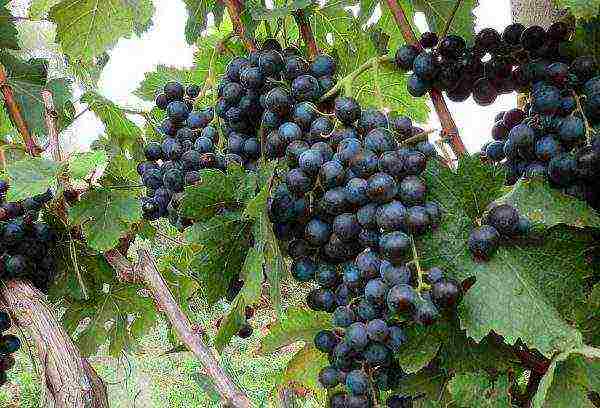
Purple early nutmeg is classified as a technical grape.
Ripening period - 115-125 days. Deep purple, round, medium-sized berries contain 21% sugar and 5 g / l of acids. Moderate fruity taste and nutmeg notes of early purple grapes are appreciated not only in winemaking, but also for making desserts. The berries contain 2-3 seeds, the average weight of the brushes is 200-300 g.
Most of the technical varieties are Muscat (Muscat Blau, Muscat Don). Platovskiy is a very early, white-fruited variety intended for the preparation of dessert wines. Zalandede and a gift from Magarach are the "parents" of an early-maturing wine variety. The berries are round, white, with a pink side. Bunches - up to 200 g, sugar accumulation - 22%, acid - 8 g / l.
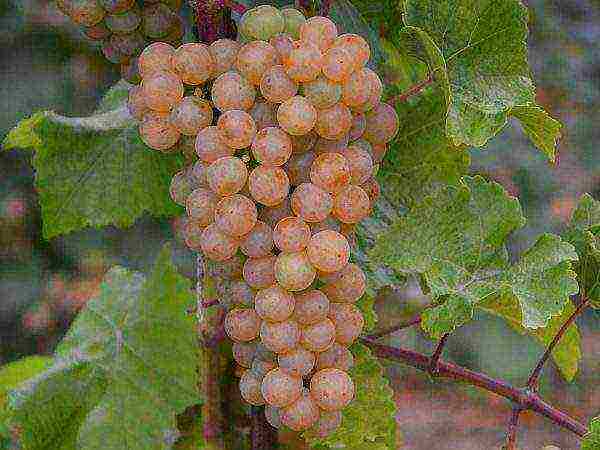
White-fruited variety Platovsky
Pinot Tin and Rondo are early technical varieties with medium yields. The berries are round, black-purple, with sourness. Wines from these varieties are of high quality, highly acidic, and nutmeg is especially noticeable when the wine is aged for a long time in wooden barrels.
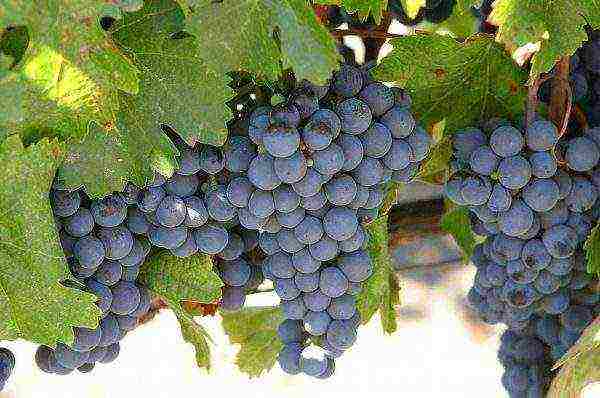
Technical early-ripening variety Rondo
The frost-resistant Pinot Tin variety is valued for its rich nutmeg flavor and bright purple color of berries, and when ripe, it is soft purple. The berries are round, blue, the juice is not colored; 2-4 bones. The weight of the bunches is from 200 to 500 g. The flowers are bisexual, the bushes are powerful and vigorous. Powdery mildew resistant hybrid.

Early ripening Pinot tin (Pinotin) ripens after 120 days
Early grape varieties for regions with description and characteristics
Early grape varieties are subdivided into ultra-early, super-early and early. Grape forms are selected for the climate of the region and the qualitative composition of the soil on the site. The correct choice of the variety affects the survival rate on the site and the yield of the crop.
Varieties for growing in Ukraine
In Western Ukraine and in the eastern regions of the country, early and ultra-early grape varieties are grown not only in the open field, but also in greenhouses.... Whole hectares in the Kherson, Odessa, Nikolaev regions are occupied by greenhouse grape fields. Such agricultural technology allows you to get large, sweet grapes of the varieties Julian, Harold, Galahad, Delight, Alyoshenkin in the second decade of June.
Dark-fruited Lorano and Nesvetaya's Gift ripen after 90 days, the amazing Rhombic variety with finger-shaped fruits becomes sweet and tasty after 80–90 days from the beginning of the growing season.
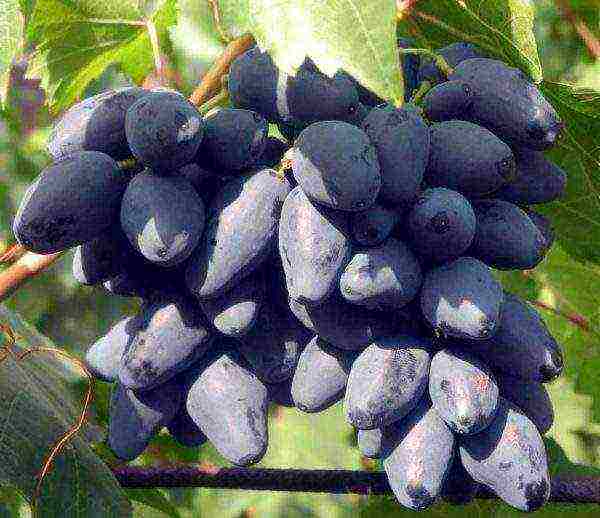
Ultra-early variety Rhombik, known in Ukraine
And also in Ukraine, an incredibly early harvest is obtained from the early ripening variety Catalonia, the first bunches of which ripen in 85 days. The berries are dark blue, juicy, with a cherry aroma and light astringency; with delicate skin; contain up to 24% sugars and 6 g / l acids. The maximum weight of bunches is 1200 g. The hybrid is resistant to gray rot, does not crumble and remains on the bushes for a long time at full ripeness.
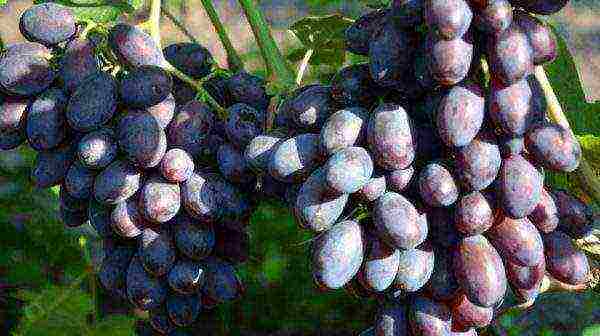
Super early grape variety Catalonia
Growing ultra-early grapes in greenhouses requires forced additional pollination and timely organic and mineral fertilizing.
Video: overview of early grape varieties in Ukraine, end of July
Varieties for cultivation in Volgograd
Early-ripening varieties and grapes with a late ripening period are grown on the Volgograd land in a sharply continental climate. The experience of gardeners shows that proper care, regular pruning and rationing of bushes, feeding and treatment from mildew and powdery mildew are a guarantee of stable and decent yields in the vineyard.
Libya and Kishmish 342, Julian and Vega are grown here; Super extra, Arcadia, Tason - vigorous varieties with a vegetation period of up to 110 days, and low-growing Superearly red muscat, have long taken possession of the vineyards of Volgograd residents. Very often on the plots of winegrowers there is an early Volgograd with dark blue berries and elongated bunches (period 110–120 days).

Early ripe variety Volgogradsky early
Video: early ripe grapes in the Volgograd region
Varieties for growing in the Rostov region
In the climatic conditions of the Rostov region, most of the ultra-early table and technical grape varieties fully ripen. The most famous grape hybrids:
- Julian;
- Delight;
- Libya;
- Laura;
- Galahad;
- Codryanka;
- Arcadia.
In the Rostov region, wine viticulture and the cultivation of dessert and wine varieties of seedlings are developed. Despite the fact that the region is located in the northern zone of industrial agriculture, not only domestic varieties have spread here, but also grape forms bred in the USA - Pink Seedlis, Ainset Seedlis. The vine requires shelter in the winter and preventive treatments against powdery mildew and fungal diseases of grapes.
The most famous zoned early ripening varieties: Delight, Pearl Sabo, Zorevoy. A covering universal variety Druzhba is grown with white-yellow moderately sweet fruits with fruity notes. The growing season is 110–120 days.
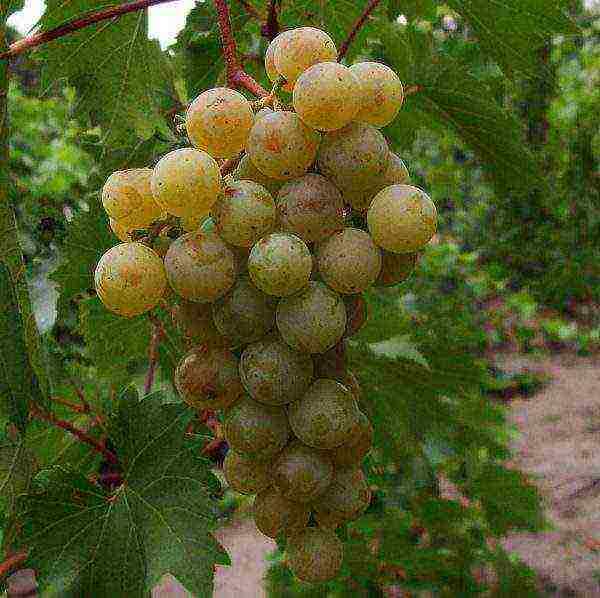
Early universal variety Druzhba
Varieties for cultivation in Belarus
On the Belarusian land, they often cultivate early and ultra-early forms of grapes in order to get the maximum yield from each vine in a temperate continental climate with the impact of Atlantic cyclones. Gardeners are trying to choose the most frost-resistant varieties that are practically not exposed to powdery mildew.
Popular varieties are Aleshenkin, Minsk pink, white-fruited with pink Tukai, Transfiguration, Julian. In the Vitib region, the ultra-early Riddle of Sharov of Altai selection with round purple berries was very fond of. The variety tolerates frosts down to -30 ºС and does not require shelter for the winter.
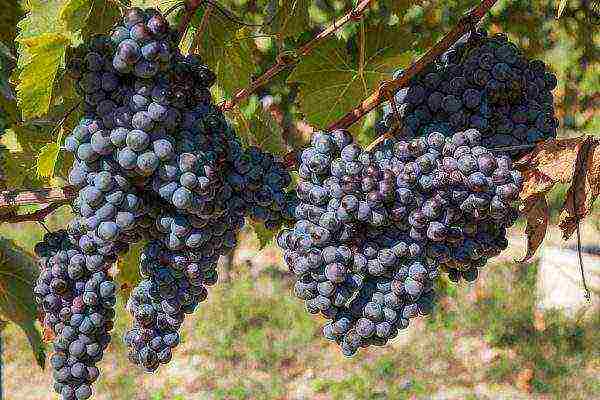
A hybrid of Siberian selection Sharov's Riddle has long taken root on the Belarusian land
Rusbol and Tason are prized for their large bunch and sweet fruits. These varieties ripen in Belarus at the end of July and require shelter in winter. Ultra-early Super Extra and Arcadia allow you to get up to 8-12 kg per bush, if planted on well-heated, fertile soils. Large brushes and sweet berries are obtained with timely normalization of the shoots and a moderate load on the bush.
Varieties for growing in Siberia
In Siberia, a decent harvest is harvested from zoned varieties of early ripening.For the northern regions, ultra-early varieties of grape forms are most relevant, which in 95-110 days manage to grow the vine, give a strong ovary and gain juiciness and sweetness. It is important that the varieties are adapted to the harsh Siberian climate and firmly endure return spring frosts, the influence of northern winds and early autumn colds.
Here they grow an early-ripening variety of Siberian selection Tukai with soft green, sweet fruits ripening in early August, a white-bellied Muscat Rusoven and a dark blue frost-resistant variety Muromets. Popular here are Kodryanka, Hercules and Bashkir early, Russian early and "local" varieties of the Riddle of Sharova. In Siberia, all grape varieties require abundant moisture recharge in the fall and a reliable shelter for the winter.
Video: early grape varieties for cultivation in Siberia
Gardeners reviews
Most of the early-maturing varieties deserve the universal love and respect of experienced winegrowers for their early maturity and resistance to fungal diseases of the vine. Having a couple of ultra-early varieties on the site, you can enjoy juicy, aromatic berries in the middle of summer. The abundance of very early varieties of grapes and the variety of quality characteristics open up tremendous opportunities for both experienced winegrowers and novice gardeners.
Mena's name is Oksana. By education - an accountant, by vocation - an artist and a mother. I love to travel and appreciate in people sincerity and reliability.
There are super early, early, mid and late grape varieties. Each of them has its own characteristics. Of course, early and super early varieties are in greatest demand. Their berries are poured in four months or less. The article will describe the most common early grape varieties, their characteristics, taste.
Description of white and green early grape varieties
- "Timur" ripens by 104-116 days. Bunches of 600 g, not dense, conical. The berries are elongated, pointed at the end. Straw-white color. The grapes are crispy, sweet with nutmeg. Withstands up to -26 degrees and almost never gets sick.
- "Laura" refers to early grape varieties, ripens in 110-115 days. The shape of the brush is conical, loose, weighing 1 kg or more. The berry (9 g) is oval-round, light green. It is always marked with a layer of "wax" and may have an orange tan from the sun. The flesh is pleasant, and the bones are large. It tolerates frosts down to -23 degrees, is resistant to diseases and tolerates transportation well over long distances.
- "Augustine" gives an early harvest, already by 115 days from the beginning of the season. The brushes are small, up to 500 g, not dense. The berry is also small - 5.8 g, green-yellow. Very resistant to low temperatures. Can survive even at -30 without insulation. Unpretentious look, gives a stable, large yield. If it is not possible to immediately collect the bunches, they can be stored on the vine for up to 1 month without losing their taste and external qualities.
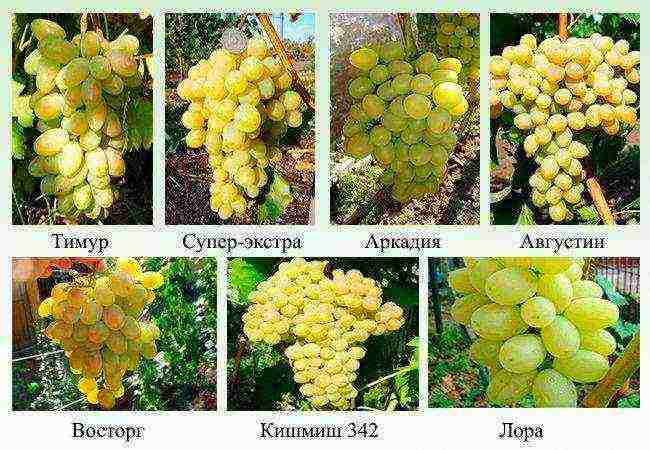 White and green early grape varieties
White and green early grape varieties - "Delight" belongs to one of the most common early grape varieties - the first bunches ripen 4 months after the appearance of foliage. The shape of the bunch is conical, dense, weight up to 2 kg. Berries (7.3 g) are straw-white, rounded, may have golden barrels from the sun. The pulp is sweet, crunchy, the skin is not tough. Withstands frosts down to -26 degrees.
- "Kishmish 342" ripens within 4 months. The grape weighs up to 3.5 g, oval, yellow-green, seedless. The bunches are large, up to 500 g one piece, loose, have a cylindrical shape. The plant tolerates frosts down to -26 degrees.
- "Arcadia" gives the first ready-to-eat fruits by 125 days from the day the leaves appear. The bunches are dense, conical, and can weigh up to 2 kg. The berries are huge - 15 g one piece, blunt conical shape. The color is green-yellow. It tolerates frosts down to -21 degrees, it is resistant to transportation and diseases.
- "Super extra" will sing for 125 days. Small brushes within 500 g.Berries 7 g, oval. The color is straw-white. The taste is simple. The disadvantages include rough skin. Withstands up to -29 degrees of frost.
Pink and red varieties
- "Julian" - an early grape variety yields a harvest 95 days after the appearance of the leaves. Huge clusters are of medium friability. The berries are oval or rounded, bright pink. The peel is not perceptible when chewing, the taste is sweet, crunchy. Resistant to frost down to -24 degrees. It can be transported over long distances due to its immunity to most diseases. It deteriorates slowly.
- "Victor" belongs to very early varieties. You can get grapes of this type in 100-110 days from the appearance of the leaves. A bunch in the shape of a cylinder. The color is bright pink with a purple tint after full maturity, but can break even when it reaches a yellow-pink color. Frost tolerates up to -30. Not afraid of fungal diseases. A demanding culture, it grows only on fertile soil - fertilizers are required at different periods.
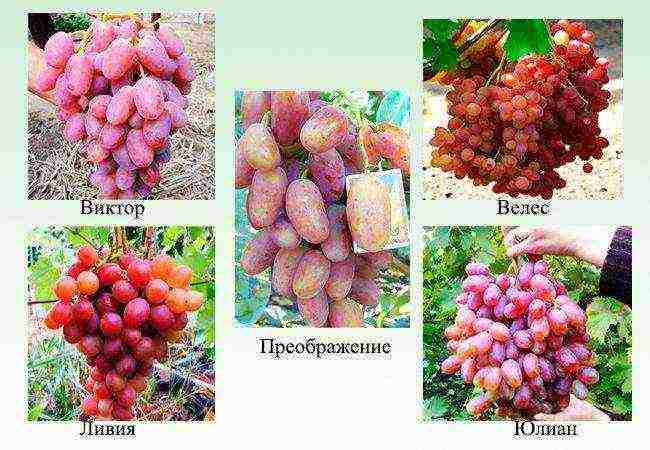 Pink and red early grape varieties
Pink and red early grape varieties - "Veles" can be consumed 105 days after the leaves bloom. The bunches are large, the berries are oval. Very tasty, has a bright pink color. Recommended for raw food consumption. It can survive at no more than -21 degrees, but additional insulation is desirable.
- "Libya" can ripen at 110 days. The brush is elongated, not dense. The berries are ovoid, reddish-purple in color. Gives off a nutmeg aroma, sweet, juicy. Pitted, but easy to separate, edible skin, not tough. Withstands frosts down to -21 degrees, and is stored in a cool place for no more than 33 days.
- "Transfiguration" ripens 115-120 days. It grows as a large bush, so it is best to shape its appearance, otherwise it will grow on the floor of the garden. The bunch is of different shapes, medium density and weighs up to 1.5 kg. The berries are slightly elongated (15 g) pink-red. It is a juicy and sweet look. It can withstand frosts down to -15 degrees, it can be stored for no more than a week.
What blue and black grapes are early ripening? 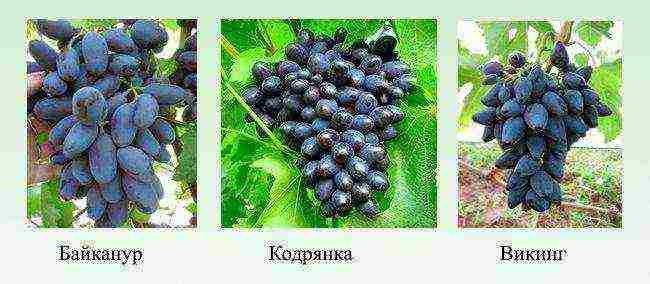 Blue and black early grape varieties 1
Blue and black early grape varieties 1
- "Kodryanka" very popular. This early grape variety, with proper care, yields 96-110 days from the day the first leaves appear. The brush weighs up to 600 g (record - 1.5 kg). The berry can weigh about 8 g - large, elongated blue-violet. Gives a stable high yield from year to year. Withstands frosts down to -22 degrees. Of the shortcomings, a tendency to peas is noted. The taste is pleasant, dry, does not deteriorate from hanging on the plant for a long time.
- "Viking" ripens 100-115 days from the appearance of the kidneys. The bunches are clearly conical. The berries are black-indigo, elongated and pointed on one side. Temperature up to -21 degrees will endure calmly, rarely gets sick.
- "Baikonur" yields a harvest 100-115 days from the day of budding. Grozi up to 1 kg, have a dark purple color. Elongated berries - 11.7 g. Very tasty, the skin can be eaten. Frosts at -28 are not terrible for him, as are most diseases. Resistant to transportation.
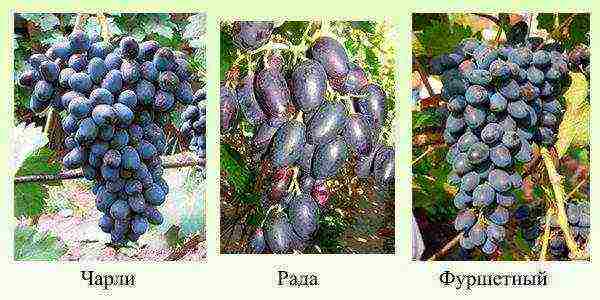 Early blue and black grapes
Early blue and black grapes - "Charlie" ("Anthracite"), with proper care, will yield 105 days after the start of plant development. Bunches of 700-800 grams. The grapes are about 7 grams, dark, almost charcoal in color. Has no tendency to pea. Not afraid of frosts down to -28 degrees.
- "Glad" ripens in 115 days. The bunch is not dense, weighing 800 grams. The berries are large, 8 grams long each. Indigo or closer to black. Differs in juiciness, very aromatic. At a temperature of -21 or more, it may die. Stored and transported without problems, resistant to many diseases.
- "Buffet" can ripen from 115 to 125 days, depending on the conditions of detention. The bunches are dense, large up to 800 grams. The berries are very large, oval, weighing 12 grams. The taste is excellent, the skin is not tough. Frosts at -22 are well tolerated, rarely gets sick.
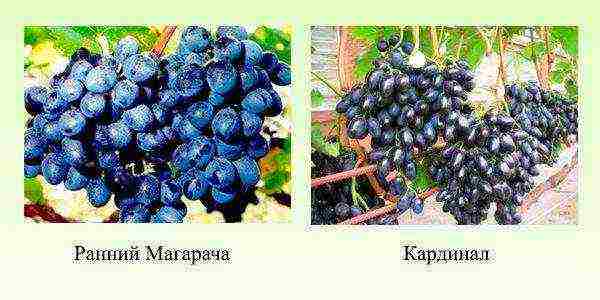 Blue and black early grape varieties 3
Blue and black early grape varieties 3 - "Early Magaracha" Is a tasty but capricious early grape variety.Ready to use for 4 months from the appearance of the kidneys. Brushes of 500 g, and fruits of 4 grams. The color is blue-black, but there is a rather thick layer of white "wax", the taste is normal, has 2-3 seeds. The juice turns out to be pink-red. Frosts below -20 degrees are fatal. It can often get sick, especially with a lack of feeding.
- "Cardinal" ripens 4 months. The bunch weighs up to 500 grams, not dense. Grapes (11 g) are round. The color is red-violet - more dark, with a touch. In grapes up to 4 seeds. The taste is delicate, sweet can give off the aroma of nutmeg. Among the shortcomings, it is worth mentioning the tendency to disease, peas, the instability of the crop, the fear of even small frosts.
